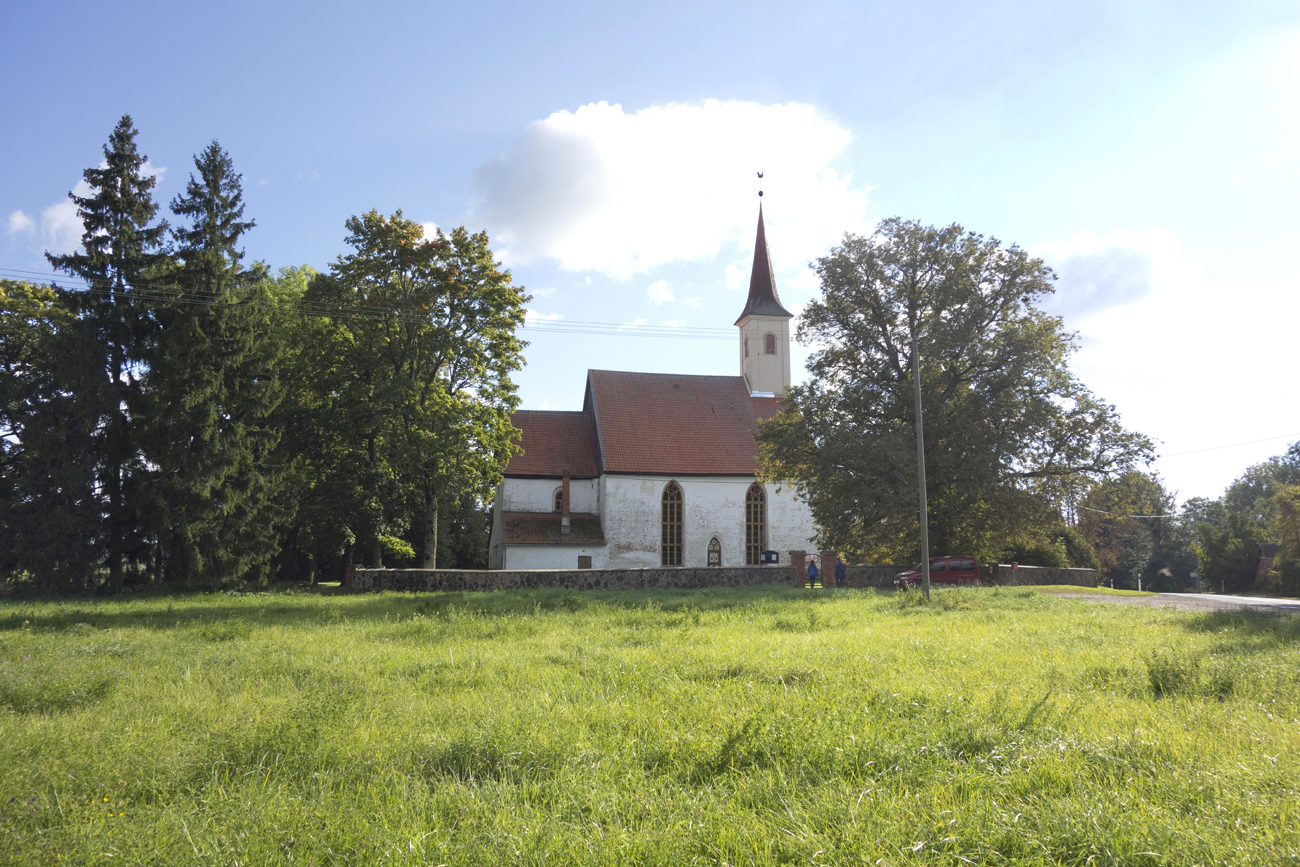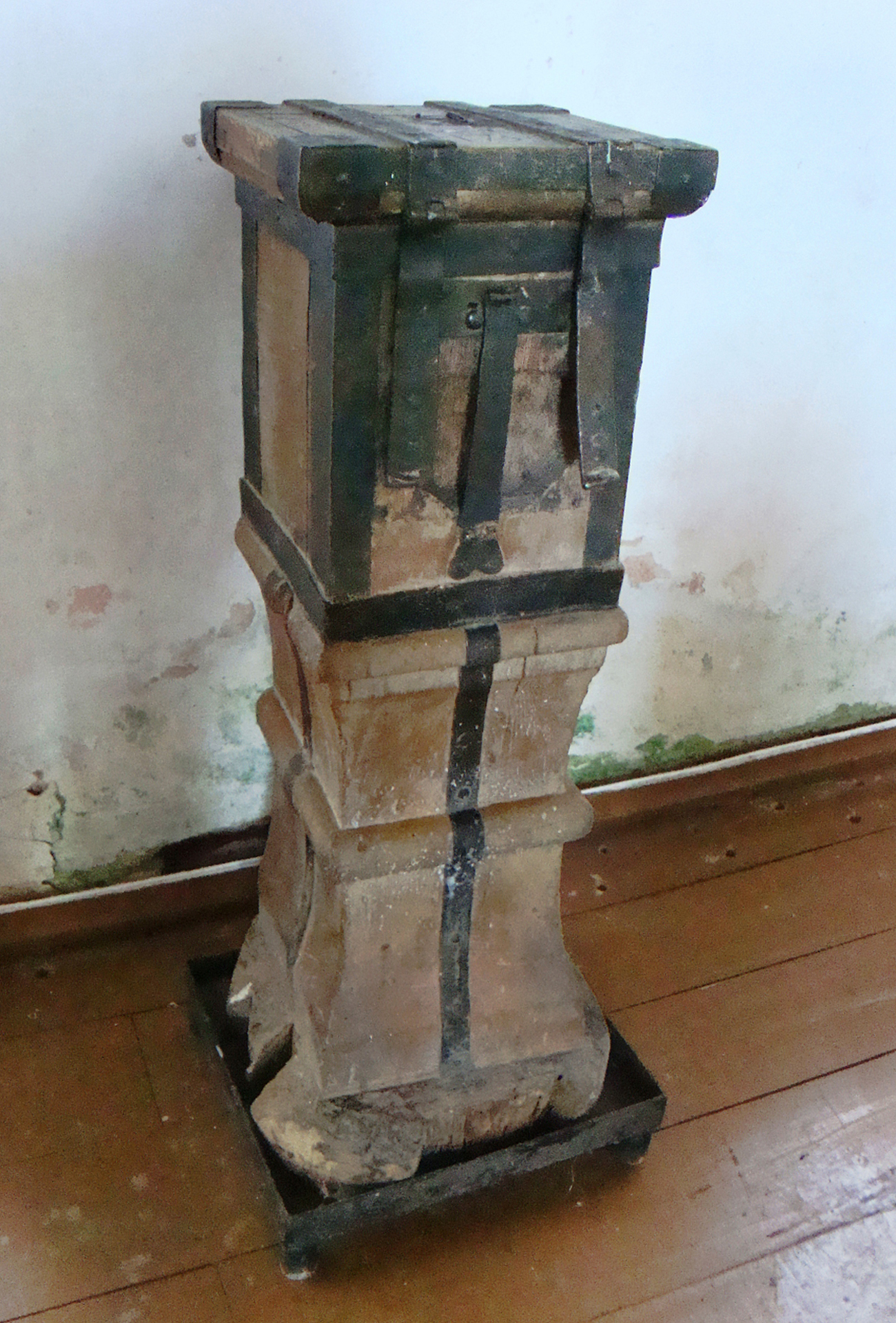Rannu St Martin’s Church in Neemisküla
Rannu was one of the ancient Ugandi parishes by Lake Võrtsjärv, which was given to the von Dolen family in 1224. It is not known when the first church was built in Neemisküla. Numerous wars have left their trace on older architectural heritage in southern Estonia. Especially destructive were the battles between Poland and Sweden in the first decades of the 17th century – nearly all rural churches stood in ruin afterwards. The same happened in Rannu where only part of the walls have survived of the medieval church; particular truss gables were constructed, as happened in St John’s Church in Viljandi, probably only after the Great Northern War. The appearance of the church changed a bit also in the 19th century – in 1835 a wooden tower was added and in 1876 the windows were enlarged.

There are usually no written records about the construction of our medieval churches. Sometimes a church contains a small detail that can offer at least some information about the dates. Rannu has a remarkably short and wide nave, where the vaults were supported by just one pair of pillars. Churches with such proportions began to spread in southern Estonia in the 15th century. The reason was obvious: people wanted to look around during the service, listening was not enough.
The vault consoles of the nave are quite eloquent, unusually for southern Estonia they were made of limestone. Their form structure says clearly: the consoles were carved by Tallinn masters in the quarry of Lasnamäe. Stone details were produced there mainly for a specific building. Some of the production, however, was a kind of catalogue merchandise, and the Rannu consoles probably belong in that category. They enable to place the church in the first half of the 15th century – possibly in the second quarter.

Similarly with many other of our rural churches, there were at least two side-altars in Rannu besides the main altar, indicated by altar and sacrament niches on two sides of the triumphal arch in the eastern wall of the nave.
The chancel room was richly decorated and thanks to three big windows also extremely well lit. Because of later extensions and the altar wall, the windows are now partly closed. The room was covered with a stellar vault, similar to that in Puhja church. Today, only scant fragments of the vault ribs have survived. In the corners, the vault was supported by capitals with late-Gothic decor made of fired clay that are quite rare in Estonia. This is the only case in southern Estonia besides St John’s Church in Tartu where terracotta decor is used.


The real treasure of Rannu church is its pulpit, or more precisely, the panels of its parapet. The facets of the polygonal corpus show the reliefs of Christ, Aron, Moses and John the Baptist. Especially striking is the carved decor, which often indicates most precisely the completion date of a Renaissance or Baroque ear work. Back then, various pattern books were widely spread, where the masters of the Occident could see what was in vogue at the moment. The Rannu pulpit has a plait-work ornament with dolphins as one of the main motifs. Such Islamic design reached Europe via Spanish Moors, hence the name – moresque. The pulpit was certainly produced at some time in the middle of the 16th century and is therefore the oldest in the Baltic region. It was probably first used in a church in Tartu and brought to Rannu when the church was restored in the 1640s. For urban people, it was already hopelessly old-fashioned. When the pulpit was set in place its general shape was altered and a sounding board with small heads of angels was added. The stairs to the pulpit are even of later date. The original polychromy was also later painted over.


The altar wall, made in the workshop of the Tartu carpenter L. Bandelier in 1890 shows Rudolf Julius von zur Mühlen’s painting „Crucifixion”. Incidentally, Bandelier’s furniture workshop has a firm place in our art history as well: in 1897, Konrad Mägi started work there as a woodcarver who, because of his job, had to attend art courses as well. After this came the Stieglitz Art School in St Petersburg.
Kaur Alttoa, 2016
RANNU AND ESTONIAN WAR ON INDEPENDENCE
At the beginning of January 1919 was the hardest time in Estonian War of Independence. The enemy invaded Estonia and conquered a large part of the young country. Narva, Rakvere, Tartu and Valga were occupied by the communist’s troops. The next Bolsheviks war catch seemed to be Viljandi. The Red Army was from Tallinn only a few tens kilometers away.
The battles between January 2nd to 7th were a breakpoint in War of Independence which stopped the Red Army’s further penetration. To this followed by a general offensive on the Viru front and the liberation of Tapa. On January 14th was taken back Tartu by surprise attack and by January 19th was released also Narva.
In the attack of Estonian forces in Southern Estonian participated also The Volunteer Battalion of Tartu, which was formed in Viljandi. After the fall of Tartu into the Bolsheviks on December 21st 2018, the members of the Defense League back down to Põltsamaa and from there to Viljandi, including students from Treffner High School and Commercial School, who could not join with the Julius Kuperjanov’s partisan troops, formed in Puurmani. In this battalion were about 120 men. The commander of the Battalion was appointed former Tartu’s militia commander, artillery sub-lieutenant Karl Einbund, the later Prime Minister of the Republic of Estonia, after names estonianized known as Kaarel Eenpalu. The commander of First Company was Captain Oskar Eller and the commander of Second Company was the chief-lieutenant Martin Libene, they both were killed in battles.
On the evening of January 13th, the Volunteer Battalion of Tartu started to move from Viljandi to Tartu, but in Rakke they turned up to Rannu towards. On their journey they passed the Rannu Church. In the early morning of January 16th, started an assault on Rannu Manor, which was taken back from the Bolsheviks. During this action, the Volunteer Battalion of Tartu also suffered losses. In the battle fell a pupil of the Tartu School of Commerce Oskar Ahas, whose home was only a few kilometers away from the Rannu manor, in Kipastu village, in Petso farm. Later died in wounds Boris Kofkin, the warrant officer of First Company.
On the evening of January 17th, the Battalion left from Rannu’s manor and moved to Valga, where was held a smaller battle with the Bolsheviks, after that they moved to Rõngu. To moving forward was complicated. Tartu was already liberated by Estonian armored train troops who arrived to Elva on January 17th, but stumbled behind the broken railway bridge. At the same time the Red Army’s 8th Novgorod Hunting Regiment, the Latvian Red Hunters and the Chinese made up mines and demolition division developed for a counterattack, which pushed out the Volunteer Battalion of Tartu from Rõngu and then from Valga. The Battalion retreated to Rannu and then to the Rannu’s Church manor. Thus, the Rannu Church has a significant role in the war way of the Volunteer Battalion of Tartu: no further retreat beyond this, the enemy attack was stopped and the Bolsheviks could not to invade any further.
On the night of January 23rd, the Kuperjanov’s partisans arrived to Elva and proceeded to move towards Rõngu. On January 24th, the Volunteer Battalion of Tartu left the Rannu Church manor and participated in the liberation of Rõngu on January 25th with the Kuperjanov’s partisan troops. The Battalion’s war way continued from Pikasilla via Hummuli to Valga.
Alo Lõhmus, 2018

Tartu School Students Armed Unit, in March 1919. National Archives of Estonia.
On November 11th, 2018 in the Rannu’s Church Yard was blessed a Pilgrims Prayer Bench, dedicated to the 100th birthday of the Estonia Republic and to the soldiers and to the fallen heroes, who fought under the Rannu and Rõngu battles in the War of Independence. Without them, we would not have the Free Estonia, neither today nor tomorrow.
To the Liturgy Service in the Church of Rannu had come many local people and friends of the Pirita Convent. After the service, Minister of Rannu St. Martin’s Congregation, Timo Švedko consecrate the Pilgrim’s Prayer Bench in church yard. His blessings warmed up our hearts, despite a windy day and dark sky. Many thanks! Thanks to Toomas Kund, who made that Prayer Banch, as well to Alo Lõhmus, Jaan Eensaar and all the lovely Rannu’s people, who have been sharing his advice and assistance with us.

